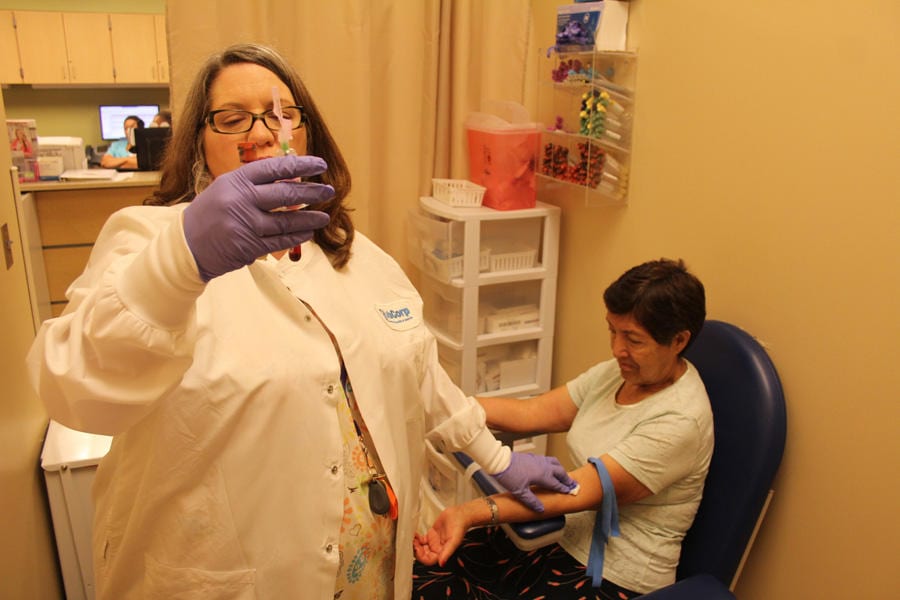Changes Ahead For Shawnee County Safety Net Clinics

Published July 30th, 2015 at 8:59 AM
The switch from county oversight to management by a Wichita-based nonprofit is under way for the four safety net clinics in Shawnee County.
Together, the four clinics provide health services to about 8,000 patients a year, regardless of their ability to pay.
That sounds like a lot. But for a county with 20,500 uninsured children and adults, health officials say it’s not enough.
“We know there are people we are not reaching who are uninsured or who are just in need of an affordable medical home,” said Alice Weingartner, director of the Community Health Center at the Shawnee County Health Agency, which runs three of the Topeka-based clinics.
The gap between health care needs and access to care hasn’t gone unnoticed. In 2013, executives with the two hospitals in Topeka — Stormont-Vail HealthCare and St. Francis Health — convened what became known as the Shawnee County Safety Net Summit, a wide-ranging discussion aimed at making the clinics more efficient, expanding their reach, diversifying their funding and diverting uninsured primary- and preventive-care patients from the hospitals’ emergency rooms.
Over the next two years, the Sunflower Foundation awarded the summit group two grants, which it used to hire a national consulting firm that eventually recommended turning the four clinics’ operations over to GraceMed, a Wichita-based nonprofit with eight safety net clinics in Wichita.
Download the Shawnee County Safety Net Report – Part I
Dowload the Shawnee County Safety Net Report – Part II
“What this means is that Shawnee County Health Agency clinics would no longer be part of county government,” Weingartner said. “We would be under GraceMed.”
“The biggest reason,” she said, “is that health care is changing so rapidly these days, it’s hard for the government-run model to keep up. Going with GraceMed will give us a lot more flexibility.”
Decision-making processes — assembling the resources to apply for a federal grant, for example — that should take a few days or weeks to complete often take two or three months in Shawnee County, she said, because the clinics first have to approach the Shawnee County Health Agency board, which in turn has to run the proposals by Shawnee County Board of Commissioners.
That switch to GraceMed will make that process more efficient, Weingartner said.
Long-term goals
The summit group’s five-year goals include boosting the reconfigured clinics’ annual caseload to 25,000 patients and weaning their reliance on the county general fund.
“We’re hoping that in the short term, the county will continue to support the clinics,” said GraceMed CEO Dave Sanford. “But, yes, the long-term goal is to get to a point where there’s no county funding.”
Currently, county funding — $2.2 million a year — accounts for about a third of the county-run clinics’ budget. The remaining two-thirds come from grants, Medicaid, Medicare, insurance companies, private pay and donations.
“The question is whether there’s a better model for providing care,” said Shawnee County Commissioner Shelly Buhler. “That’s what’s driving this. And so far, all of the different stakeholders see some longer-term benefits in going with GraceMed.”
GraceMed and the county-run clinics are federally qualified health care centers (FQHC), a designation that gives them access to federal grants and tort coverage.
Marian Clinic, an “outreach ministry” of the Sisters of Charity of Leavenworth, is the fourth safety net clinic in Shawnee County but does not receive county funds and is not an FQHC. The clinic runs the only dental practice for uninsured and underinsured patients in Shawnee County.
In a prepared statement, Marian Clinic Executive Director Glenda DuBoise last week said: “We continually assess the changing health needs within the community and evaluate how we can best meet those needs. Just as our communities continue to evolve, so must Marian Clinic. As a trusted safety net provider in our communities, we are committed to updating our associates, clinicians, patients and families of any actions we may take to better meet local needs.” She declined requests for an interview.
Aiming to change in 2016
Since December 2014, county officials — a group that includes the governing boards of the three Shawnee County Health Agency clinics and Marian Clinic — have been filling out the paperwork for transferring the four clinics’ operational credentials to GraceMed by Jan. 1, 2016.
“It’s a long, drawn out process,” said Sanford, who’s also a past president of Kansas Association for the Medically Underserved.
The credentials, issued by the Health Resources and Services Administration within the U.S. Department of Health and Human Services, allow the clinics to receive Medicaid and Medicare reimbursement.
The process is complicated, Sanford said, because it involves clinics’ governing boards giving up their credentials and the federal government agreeing to let GraceMed take them on.
The arrangement also will need to be approved by the Centers for Medicare and Medicaid Services.
“We’re telling people this will not be a merger,” Sanford said. “This will be the closing out of two organizations and the opening of a new one.”
‘A good thing’
The current clinic setup in Shawnee County is unique in Kansas, said Jason Wesco, chief executive at the Health Partnership Clinic in Olathe that operates safety net clinics in Olathe and Paola.
“One of the challenges in Shawnee County has been that the health centers (clinics) use what’s called the public model,” he said. “It’s a model that’s not really favored by the feds anymore because it’s hard for a health center board to be completely independent when it’s beholden to a health department or to a county commission or to local politics.”
In Kansas, there are 18 FQHCs. That includes the Flint Hills Community Health Center in Emporia, which went through a similar transition from a public entity to a private FQHC that contracts with the county for public health services.
By design, Wesco said, FQHCs are meant to be independent, patient-governed and “nimble” organizations.
“The public model makes it really hard for that happen,” he said. “Nobody else in Kansas operates under that model. The rest of us are all independent nonprofits.”
Ultimately, dropping the public safety net clinic model will make operations for the Shawnee County clinics more efficient, Wesco said.
“Regardless of who’s operating the health centers in Topeka, their being an independent entity will be a good thing,” he said.
Other administrative factors in the mix include:
- The county-run clinics’ employees are represented by Teamsters Local Union 696, and about one-third of them are vested in the Kansas Public Employees Retirement System. GraceMed employees are not unionized but have access to a 403(b) retirement plan.
- GraceMed and Marian Clinic are faith-based organizations, while the county-funded clinics are not.
- GraceMed and the county-run clinics receive Medicaid and Medicare payments. Marian Clinic does not.
Logistical changes ahead
If the clinics’ credentials are transferred, GraceMed’s 17-member governing board will be expanded to include at least two representatives from Shawnee County. A Topeka-based advisory committee will be started as well.
Assuming the transfers are approved, the county-run clinic at 2115 SW 10th will close and become a satellite office of the Shawnee County Health Agency. GraceMed will take over the clinics at 2025 California and 1615 SW Eighth.
Services provided at the Marian Clinic site, now at 1001 SW Garfield Ave., will be moved to the clinic at 1615 SW Eighth, but the Marian Clinic that provides dental services will remain in its current location, 3164 SE Sixth.
Eventually, the clinic at 1615 SW Eighth will move into the first and second floors of a former nursing home between Stormont Vail and St. Francis.
GraceMed, Sanford said, has applied for a $1 million federal grant to cover the cost of remodeling the building.
Current employees at the Topeka clinics will be encouraged to reapply for their jobs in the GraceMed-run clinics.
“GraceMed is faith-based. We have a different culture,” Sanford said. “There will be a process to identify and match current staff with openings in the new organizations. We also want the opportunity to explain our vision, mission and core values so prospective staff members know what our expectations are. We will honor current employees’ seniority — things like vacation time — but there will be different insurance and retirement plans. They’ll be working for a new and different organization.”
Sanford said GraceMed’s pay and benefit packages will be “very comparable” to those in Shawnee County.
Weingartner said she’s hopeful that most of the county-run clinics’ 78 full- and part-time employees will be on board with the change.
“They are passionate about serving their community,” she said. “They’re on the front line; they are committed to helping those who need help.”
Dave Ranney is a reporter for KHI News Service in Topeka, a partner in the Heartland Health Monitor team.



